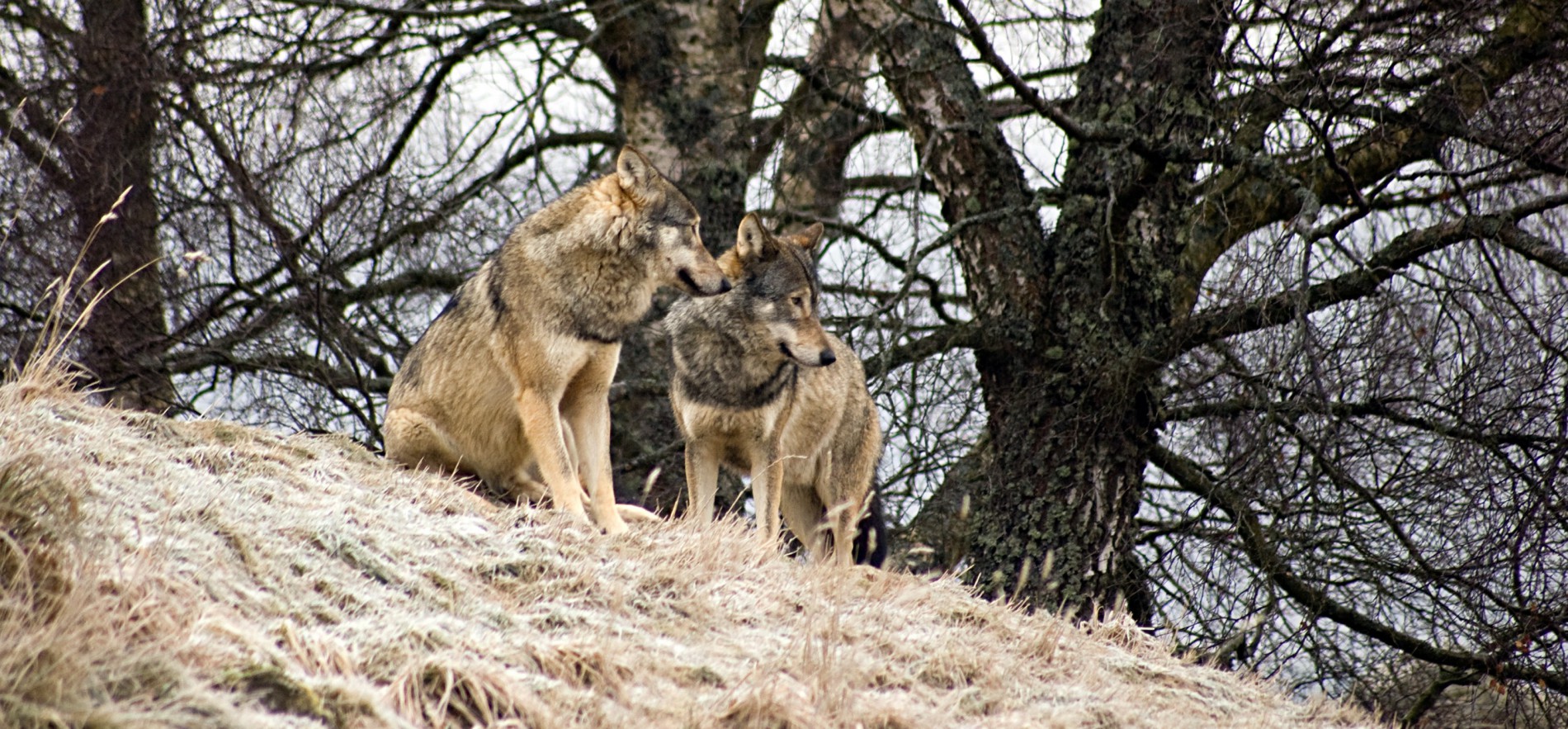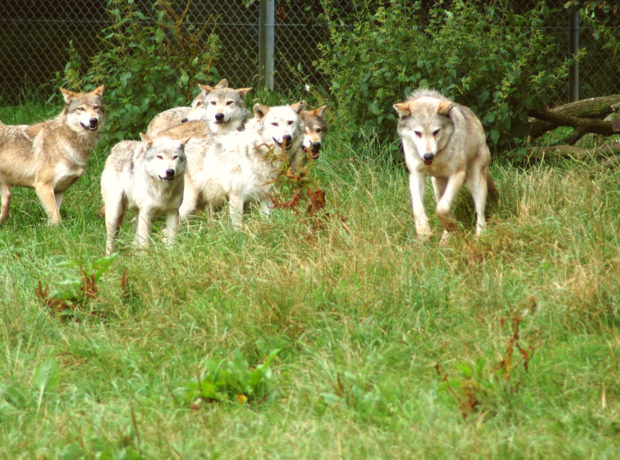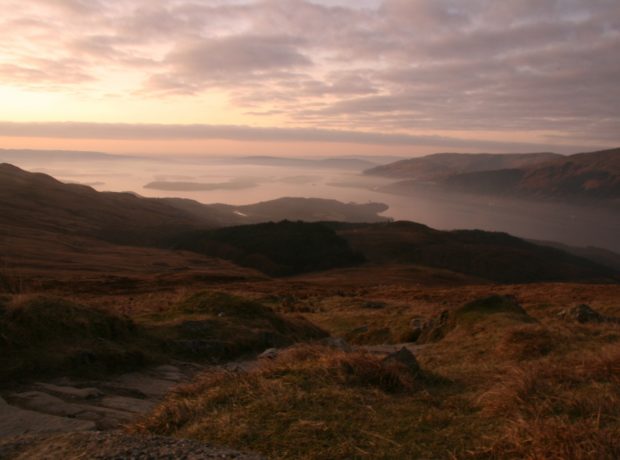Adam Weymouth considers the implications of ‘rewilding’ in the third and final part of his article exploring the future of the wolf in Scotland.
Part 3: Rewilding
The hills south of Tomatin are lower than those further north, and they are equally deserted. The midges are starting to emerge. In 2010 I walked for eight months across Europe, and despite spending much of my time in the mountains it was a rare day that I would see no one. Yet that has been much of my experience here.
Standing on the summit of Ben Wyvis, looking out every direction across barren moor to the distant sea, there’s not a soul. For days there has been nothing but heather and sheep and plantation, long grasses that soak my trousers. It is stark, austere, beautiful, empty of people and bare of trees and it is hard to put that out of my head. Yet the space and the clarity of air, the far off calls of the buzzards, bring me back to something that feels untouched at its root.
The Highland Wildlife Park, just outside Kingussie, used to only house animals native to Scotland, former inhabitants like the lynx and reindeer, and those that live here still. That remains the emphasis of their collection, but in the last few years they have begun to add some other crowd-pleasers: Amur tigers, polar bears, red pandas. It feels odd to see Bactrian camels grazing beneath the lour of a Scottish sky. I’m not sure where they come from but they seem very far from home.
I have come, of course, to see the wolves. After two weeks of walking and talking about them, the prospect of seeing them in the flesh is tantalising. An average wolf pack, rarely more than a single family with a single mating pair, averages three to eleven animals, though generalisations about them can be misleading: a pack of six in Minnesota had a territory of 33 square km, a pack of 10 in Alaska had a territory of 4,335 square km (Marvin, 2012: 24). There are four in the park at the moment, all females, two that are a couple of years old and two that were born last year. The former pack has been split recently: with the death of the alpha female, the males were shipped to Bristol Zoo before the infighting started to form a new breeding pair. The Wildlife Park is currently casting about on the continent for new blood. Ultimately they will keep just one of these females, coupled with a male from somewhere in Europe, and the pack will be born afresh.

Highland Wildlife Park Wolf. Photo by Peter Hopper
The wolves are stretched out in their enclosure, on the roof of their shelter, the four of them overlapped and entwined, the muzzle of one upon the flank of another. Unlike the camels they look entirely at home on this wet and chill spring day. Their pelage is the colours of the forest, the browns of the earth and the greys of the pines and the faint blue of the lichen. As one they raise their heads, look about. One stands, stretches with her forelegs out and her back a low curve, jumps from the roof and paces, sniffing, moving through the enclosure in a fluid, bicycling trot. The other three drop their heads again, but there is a constant hum of alertness. Pied wagtails flit about them.
I watch the first as she makes her way through the enclosure. She pauses, blinks, looks about, trots on, and there is something so familiar in her movements. Before the horse, before the sheep, before any other animal, it was the wolf that we domesticated. She returns with a bone and bounds to the roof, pins it with a paw and begins to crack it with her molars. I recognise this wolf from every dog I have ever seen, but there is something other, too. The experience is similar to witnessing someone’s madness, a glint in their eye that makes us question if they can conform to a comparable morality. That is the werewolf, and that is perhaps why such a beast thrills us so. It is not an alien evil, it is the untamed in the mundane, the feral, the failure to conform to the bounds which have been set out for the dog, and under the contract of which we allowed it into our home. Linnaeus’ name for the dog: Canis lupus familiaris.
Before any other animal, it was the wolf that we domesticated
Is mine a genuine response to a wild animal? Or cultural prejudice and fear? I am unsure. A red squirrel flits through the upper branches, chased by another.
If it is no more than cultural prejudice, that doesn’t make it any easier to shake. Half an hour later I am sitting in the office of Doug Richardson, Head of Living Collections at the Park. Doug is in favour of reintroducing the wolf, but he is under no illusions. It is not the lack of space in the Highlands: he mentions Italy and even Holland as countries where the animal is returning, amongst population densities much higher than that of Scotland. It is not the sheep farming and other livestock: he believes such difficulties are manageable with a mixture of techniques and compensation for when such techniques fail. He worked on a similar project in Singapore, protecting cattle from the tiger, with a good degree of success.
“Technically,” he says, “working out how to do it, where to do it, how to monitor it, that’s relatively easy. The problem isn’t actually the wolves. It’s dealing with the mythology. The Little Red Riding complex. The lying cow killed her grandmother, blamed the wolf, became a fairytale.” He shrugs. “The rest is a nightmare.”
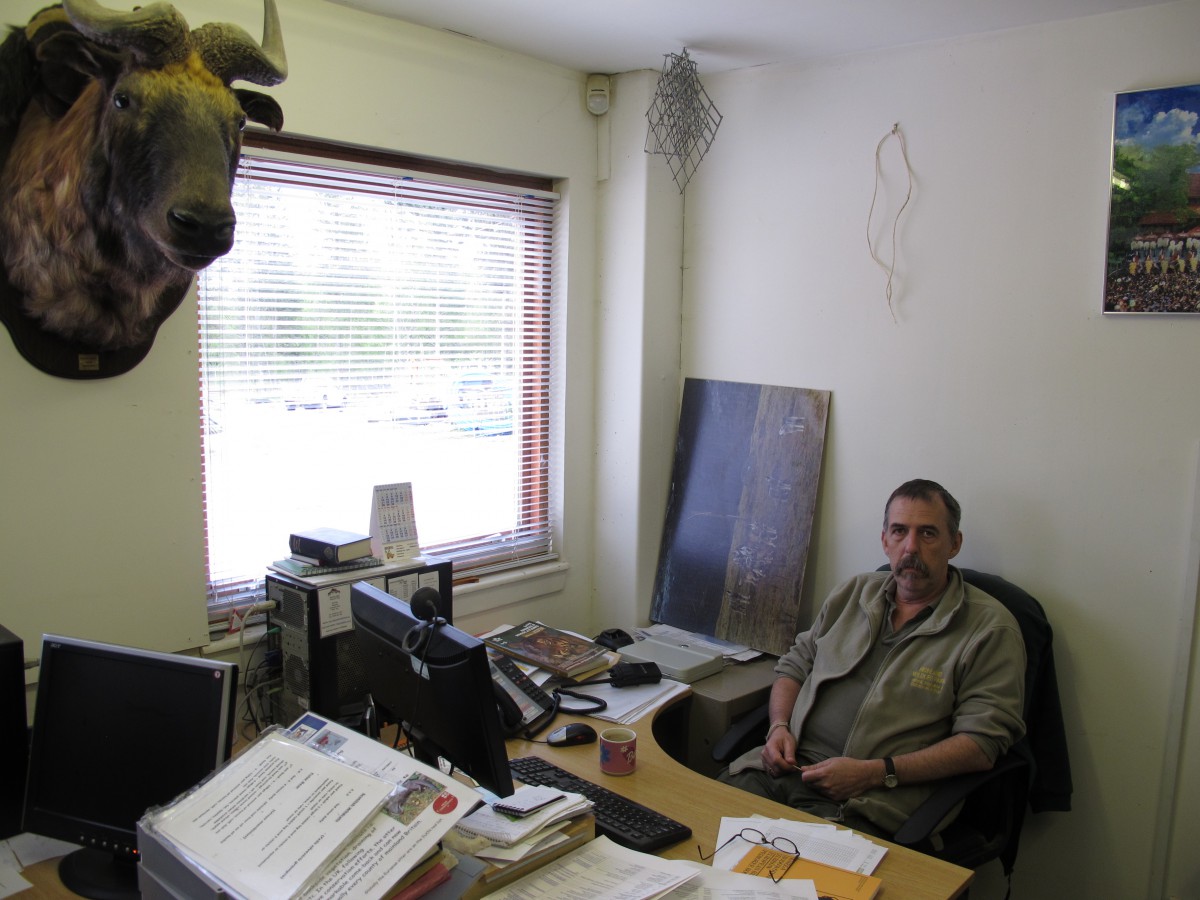
Doug Richardson. Photo by Adam Weymouth
When biologists speak of reintroducing top carnivores, they speak of restoring a “landscape of fear” (Manning, 2009). They are referring to the effects that the presence of predators can have upon their prey – herbivores that for centuries have never had to scan a skyline no longer find themselves in Eden, and instincts which have been dulled for centuries are quickly brought back to a polish. But there is a cultural fear also. Since Jesus has been associated with the lamb, the wolf has been associated with the Devil. It has riddled our dreams and our fairytales. Werewolves, along with witches, were trialled and murdered by the Inquisition, the scourge of civilisation, and eradication of the wolf became linked inextricably with modernity and progress.
Barry Lopez estimates that as many as two million wolves may have been killed in America between 1850 and 1900 (1978:180), for sport and then for bounty. There was something in their killing that bordered on the murderous, a need to make them into more than an animal driven by instinct. They had their mouths wired shut and were left to starve. They were set on fire, set upon by hounds, pulled apart by horses. A dog in heat tethered to a stake was used to lure a wolf, and when he bound to her in the copulatory tie then the wolf was clubbed to death. The extermination was so effective that by 1945 the only grey wolves left in the entirety of the Lower 48 states were on Isle Royale in Lake Superior and a handful in Northern Minnesota (194).
“People have all sorts of bizarre ideas about the relative danger of wolves, which for humans is not quite zero, but pretty close to zero,” says Doug. Since 2006 at least twenty seven people have been killed by dogs in the UK, and only two of these deaths were attributed to illegal breeds (Worrall, 2014). In the entirety of Europe, between 1950 and 2000, just nine deaths were attributed to wolf attacks, five of which were rabid (Linnel et al, 2002: 40). If we are looking for a wolf in sheep’s clothing, we might be better off looking here.
“The relative danger of wolves, for humans, is pretty close to zero”
Yet Doug believes that each fear that we harbour, whether that relates to personal wellbeing or to livelihood, must be taken into account before any further steps are taken. “It’s all doable, and I personally think it’s worth doing. But it does need to be done ever so carefully. People need to be able to vent their concerns. Let it all out. To either explain how their concern is groundless, or to suggest how their concern is valid, but here’s how it can be countered. Most people haven’t had the conversation with someone like me. They’ve had the conversation with people who have exactly the same opinion and level of misinformation as they have.”
From Idaho to Italy, the return of the Devil’s hounds has been greeted with the same polarised mix of feeling that has always dogged the animal. It is tempting to tell ourselves that we would have acted differently from how the animal was treated in the past, that we come from a more enlightened time, but whilst we might have lost our myths about most of the animals that populate our world, we still know how we feel about the wolf.
The grey wolf was the first animal in the United States to be listed under the new Endangered Species Act in 1975, but now, with its numbers on the rise, it has been delisted, and the killing has begun anew. The Humane Society reports that since 2011, 1,400 wolves have been killed in America, almost half of them in Idaho, and that populations are beginning to destabilise once again (Ketcham, 2014). In Europe it is still illegal to shoot them, but that hasn’t stopped those that feel threatened by their presence. In 2014, a wolf’s head was left suspended at a roundabout in Tuscany, along with a note calling for their “extermination” in retribution for the killings of local sheep. It was signed by Little Red Riding Hood. It is the eleventh wolf that has become a public example since March 2013 (Kington, 2014), and it is a pattern being repeated throughout Europe, wherever the wolves have been returning.
The opinions of the gamekeepers and the agricultural industry need to be given precedence
Such killings are easy to condemn, but often it is those in the cities that feel the moral outrage, whilst those who are forced to live and work alongside them feel frustration that they have not been listened to.Allen Jaggi, member of the Wyoming House of Representatives, and dealing with the growing wolf population in his state since the reintroduction to Yellowstone, has called for the release of wolves in Central Park to see how New Yorkers like it (Yakas, 2012). Any referendum on reintroduction would be skewed and, whether the reasons were couched in fact or not, demonstrably unfair. If it is ever going to work then it is the opinions of the gamekeepers and the agricultural industry that need to be given precedence.
“Those two groups,” Doug says, “if you can get them onside, they’re the lock. Everybody else doesn’t have many cards in the game. When you’ve got six, seven, eight generations doing that job, you’ve got to have a degree of compassion about their livelihood.”
Several years ago he was involved in a programme to restore the plummeting numbers of wild cats in the Cairngorms, and having the gamekeepers onside was key to the project’s success. “They were brilliant,” he says. “Absolutely brilliant. Really supportive, willing to try new things. I think the gamekeepers would be the guys I would probably start with.”
As we talk we hit up again against the idea of what a wilderness actually is.
“People have this idea that if you put a fence up, that’ll be artificial. In Eastern & Southern Africa the majority of parks have a fence. This illusion, this outdated idea we have of ‘the wild,’ it pretty much doesn’t exist. The vast majority of the planet is managed in one way shape or form. People say you’d need to constantly manage the wolves because it’s a finite area. Well, a lot of wildlife needs to be managed anyway. There’s all the kerfuffle about badgers down south. Whatever side of the argument you’re on, the badger population has to be managed. Whether that was with a culling programme or with a vaccination programme or whatever, there had to be management. That’s just the way it is.”
The year before this walk I had spent a month hiking the Sierra Nevada in California. California, of course, is known for its pines, but still I was not prepared for the trees I saw that summer. I had always been fairly dismissive of the pine tree. Deciduous trees, I felt, clearly had more personality.
Pine trees went straight up, sticking out limp branches at regular intervals; deciduous trees gnarled and boled, enmeshed, entwined, flung their limbs at rakish angles, clawed for light, were rampant with wildlife. The oaks! The limes! The beeches! But it dawned on me in California that I had just never seen an old one. The predominance of my pine experience had been slogging, despondent, through gloomy plantations of spruce, trees starved for space, condemned to logging before they hit puberty. In the Sierras I saw that when left to their own devices for several hundred years they grew equally beautiful.
The trees I saw as I walked through Glen Feshie were the first pines I had ever seen in Britain that had been given such reprieve. Some are 300 years old. Some of them may have been scratched by wolves in their youth. They had grown with mad, anarchic grace and I found I could feel something for them. Each had been given enough time and space to become an individual, with its own twists and reaches, each with its own grandeur and authority. Chaffinches and coal tits flickered through the branches. Dead limbs still stood, protruding, sun bleached or lightning struck. There were hollows amongst their buttresses to sit back and rest. And amongst them, as rare as these ancient pines, were saplings.
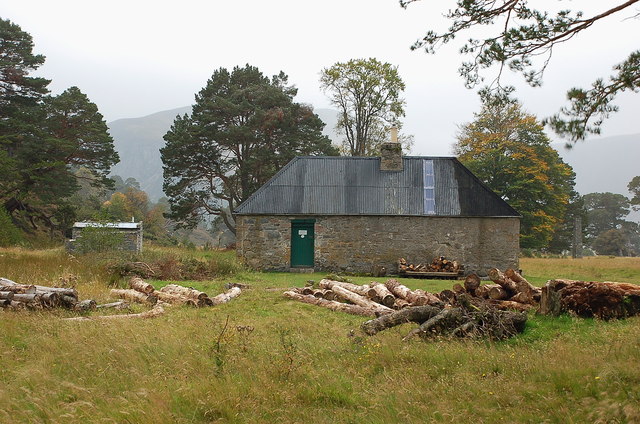
Photo by Jim Barton
A little back from the river in a grassy clearing beneath a bluff of juniper and rowan stands Ruigh Aiteachain, the Glen Feshie bothy, a one storey, two room building with a corrugated iron roof. I am nearing the end of my walk, Killiecrankie is only two nights away. It is late afternoon and a few others are converging on the place for the night. I unroll my sleeping bag on one of the wooden platforms and go out for a walk before dark. Just behind is another building, in ruins now, that was built by the 19th century painter Sir Edwin Landseer, he of the lions in Trafalgar Square, and it was in this hut that he did the preliminary sketches for The Monarch of the Glen, an image that would come to represent the Victorian, Scott-addled vision of Scotland perhaps more than any other. It is hard to buy a shortbread tin without it on. A twelve point stag framed by mist-hung mountains, austere, aloof, noble, doomed. Which is interesting, because Glen Feshie has one of the lowest deer populations in the Highlands, thanks to the commitment of its factor, Thomas MacDonell. In comparison to Alladale’s six deer per square kilometre, in Glen Feshie it is down to one, and they aim to double the area of native woodland over the course of the next five years.
Whilst eating my dinner in the hollow between the buttresses of one of these vast trees, a red deer almost walks over my feet before spotting me and bolting, its head flung forward, its ears pricked, its neck cords tight with fear. It is gone within an instant, and it leaves behind a smell of musk and a wide and empty silence. And me, thrilled, with a sense of having had an experience which is privileged. Is it wild? If it lives on a managed estate, if it has, thus far, been given reprieve from the culling? Perhaps, perhaps not. “Wild” is coming to seem like such a problematic word that it strikes me that maybe we should hesitate in using it.
The word ‘wild’ is shot through with centuries of cultural baggage
The term ‘rewilding’ was first used by the conservation biologist Michael Soule in the mid-1990s to define “the scientific argument for restoring big wilderness based on the regulatory roles of large predators.” But the word ‘wild’ is shot through with centuries of cultural baggage, from the blasted landscapes where Jesus wandered to the sublime where Wordsworth walked, a fear for the unknown and a pining for what has been lost. There are those who say that Scotland is not wild any more, that it bears the mark of humanity, and that therefore wolves have no place there. And there are those who believe that advocates of rewilding wish to remove people from the land, because the two are incompatible, and to finish what the clearances started. I don’t want to get hung up on the semantics, but many of the arguments seem to blur and ease if we recognise that the wild and the tamed are not mutually exclusive but are capable of cohabitation. Maybe, instead of speaking of rewilding, we should be speaking of restoring a richer ecology, an ecology which encompasses humans also.

Photo by Catti Maurizio
It is a mixed group in the bothy that night. A bunch of guys down from Aberdeen on leave from their work offshore, who are hitting the whisky hard. A couple of dads with their two sons apiece. A woman by herself who is cycling coast to coast. We sit around the fire, a bottle of single malt passing between us, and it isn’t long after I have explained my project that the debate is getting heated.
“It would make me more scared to walk. I grew up in the country and I still wouldn’t like them.”
“Aye, I think it would backfire on folk. Especially with kids and old folk around. But I’ll say something else. The animals that go for you, they only do it cos you’re their food. There’s no nastiness. Humans are the most vicious species there is.”
“A few might be okay. But if there were thousands of them, getting into packs. You’d have urban wolves. I wouldn’t want that.”
“I’ve never seen one, so I don’t know what I think. There’s so much wildlife up here, I think the wolves would be nice. You don’t get other animals on the streets of Inverness, so why would wolves? My granddad farms sheep up in Stornoway, I’d have to ask him. All he cares about are the rabbits eating his cabbages and the seals eating his salmon.”
“It would be a lovely thing to see. It would be a lovely thing to see. But I don’t think it would ever work.”
“We’re the problem aren’t we?”
“I’m not too good with dogs so it’s no good asking me.”
“I think you’d just need to educate folk. I was out in Canada, they’ve got bears there. You just do things a bit different.”
“There’s all the wildcats out there and you never see them.”
“Would your wife still let you come out here?”
“There’s too much grazing in Scotland.”
“This isn’t wilderness. It’s a manmade agricultural landscape. There’s no space for them anymore.”
“I’m from Poland so it doesn’t bother me. We’re used to them. Animals don’t scare me. I think people are the most dangerous species on earth.”
“I’m all for it. To be lying in your tent in the middle of nowhere and to hear a wolf cry. Now that must be quite something.”
We drift off to bed sometime later. I fall asleep to gentle snoring, to the crackle of the fire, to the sound of the Feshie rushing through the night.
I walk south, following the Feshie, and where it pools beneath a small waterfall I shed my clothes and jump in. It is phenomenally cold, my body tingles with the fire of it. The rowans are coming into blossom. It is a day of slog through peat and bog, fording the river over and again as it narrows, and then following the land as it rises into heather and finally to the close cropped grass of the summits.
On Carn an Fhidhleir, 994 metres, I add a stone to the cairn that is there. Clouds and mountains recede in every direction, some patches of snow still in the shadowed hollows. The wind is too wild to stay long. I descend over a series of smaller summits, Braigh Coire an Stuic Ghuithais, Leachdann Fèith Seasgachain, driving before me a herd of what must be two hundred deer, breaking into smaller groups, reforming, mercurial, the sound of their hooves and the rasp of the scrub on their bellies as they force their way through the heather. I lose them beyond the spine of the next hill and when I cross it they are gone. I can see for miles and they are gone. When I walked across Europe I never saw a wolf, but it was enough to know that they were there, sniffing my scent, watching, acutely aware of me. It gave another dimension to the mountains. If wolves come back to Scotland most of us would never see them, and that wouldn’t matter at all.
If wolves come back to Scotland most of us would never see them
The Tarf Hotel is a grand name for what turns out to be a rather grand bothy on a flat meadow on a bend of the Tarf Water, surrounded by crags and by peaks. I have the place to myself, there are ten beds to choose from. As the sun goes down through the perspex windows I read the bothy book cover to cover. It is oddly comforting. “17/12/2011 Rest day. Found R4 at 95.4, boosting signal with a walking pole. But signal comes and goes. Tracksterman.” The night blows in and I light candles, wondering if anyone out there sees them.
I arrive in Killiecrankie the next evening just as dusk is drawing in. The swifts are screaming. Killiecrankie is from the Gallic for aspen wood, and the sides of the gorge are thickly wooded still. I make my way down the steep path, picking my way in the failing light. A sign and a stone mark where Brigadier Balfour fell in the Battle of Killiecrankie. I pitch my tent on the valley floor and lie there, listening to the river tumble through the night.
It is a strange ending to a strange walk, a place intended to be a fitting counterpoint to Alladale, but one I have since found to be anything but. In Killiecrankie Gorge a wolf which may or may not have been the last may or may not have been killed by a man named Cameron. It probably wasn’t, and he probably didn’t. As with everything that relates to the animal, it is a blur of conjecture and prejudice and fact, a blend that seems to destined to forever revolve until such time as wolves do come loping back.
I have one more stop to make. I rent a car and head thirty miles down the road, just beyond Blairgowrie to the River Ericht, a tributary of the Tay, and take a walk out with Bob Smith. It is a beautiful evening, the rains blown out, the sun just beginning to go down.
At the water’s edge we hunker down beneath stands of maple and of willow. Bob gets out his cameras. There are others down here too, an older man with a drawn face and three not much more than teenagers, all with binoculars. We speak in hushed voices. The lull of the water, the jump of a fish. A kingfisher passes, a bolt of the wildest blue, and then, again, there is stillness.
Half an hour goes by. It is the older man that sees her first, heading cross stream, just her eyes and her nose above the surface of the water. I raise the binoculars; I can feel a grin across my face. She reaches the far bank, emerges from the water all muscle and fur, dragging behind her that long flipper of a tail. She grasps for a branch and begins to gnaw it of its leaves. I turn to Bob and I say: “well, it’s true.” “Of course it’s true,” he laughs. Hunted to extinction in the sixteenth century for their fur and their meat and the medicinal properties of their scent glands, the beaver (castor fiber) is back in Scotland.
Just how many no one is quite sure. Bob thinks the SNH estimate could be conservative, and there might already be as many as 250 through the networks of the Tay, since they first appeared eleven years ago. There is an official study underway at Knapdale, where several are being kept and monitored to explore the potential for a reintroduction, but these on the Tay are of more mysterious provenance.
This stretch of riverbank is undergoing a miniature Yellowstone of its own.
“They’re escapees,” Bob tells me. “If people say they’re illegally introduced, well that’s news to me. They’re fantastic escapologists.” There are estates around with private collections, and a petting zoo not far away. And whatever they are, they’re flourishing. This stretch of riverbank is undergoing a miniature Yellowstone of its own. The deadwood the beavers have felled about the banks, Bob tells me, provides eddies and shade for smaller fish, which in turn attracts the kingfishers, the bigger fish, the amphibians and otters. Their lodges protect the banks from flooding. And as they thin the canopy the flowers have grown back, which in turn brings in the pollinators, the butterflies and bees. A study in Inverness-shire has shown a four-fold increase in biodiversity since beavers were trialled nine years ago (Lister-Kaye, 2015). “They’re not,” he says, “called a keystone species for nothing.”
It is completely surreal to see them, for Bob to be pointing out beaver sign along the banks: here a willow stripped of its bark, here the collapse of an old lodge. And yet, like the wolves at Kincraig, they seem also to belong. I would somehow expect a new animal, a mammal that can grow as big as an Alsatian, to stand out in a landscape where they have not been known for centuries, but they merge into the banks as though they had never left. More a hiatus than an extinction. And this is not a wilderness, by anyone’s definition of the word. This is a few metres of riverbank at the end of some fields, a ten minute walk from a twenty-four hour Tesco. There have been calls for their extermination but the Free Beavers of the Tay have been fighting their corner, and for the moment they are being left alone. They are by now so established that an eradication programme would be a logistical nightmare.
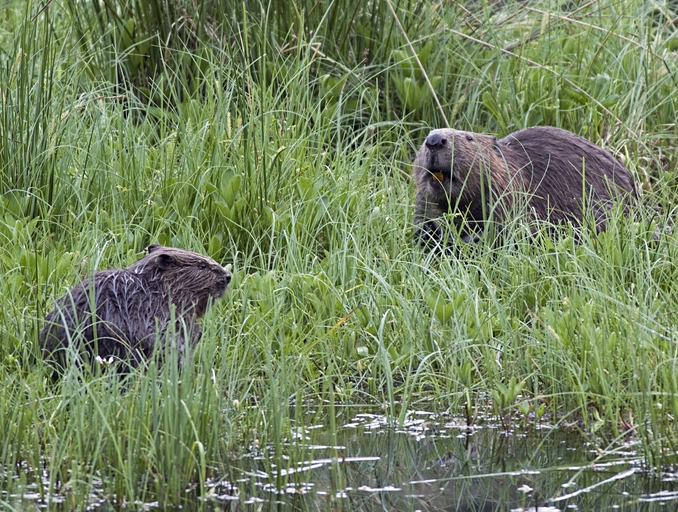
Photo by Ray Scott
I watch the others, watching the beavers. This, I think is what it’s all about. One animal watching another. With respect, and with humility, and cohabiting a space. If we were able to see the wolf for no more and no less than he is, as an animal that is different from ourselves, then maybe we could begin to live alongside them again. Repairing Scotland’s ecosystems, humans included, will only be possible if we have the courage to see the wolf not as we wish him to be, but as a wolf, different from, and undefined by, ourselves. That we have failed to do this in the past, both for wolves and for other humans, does not bode well.
But on the other bank, gnawing a branch, is a beaver.
Banner photo by Peter Hopper ![]()
![]()
